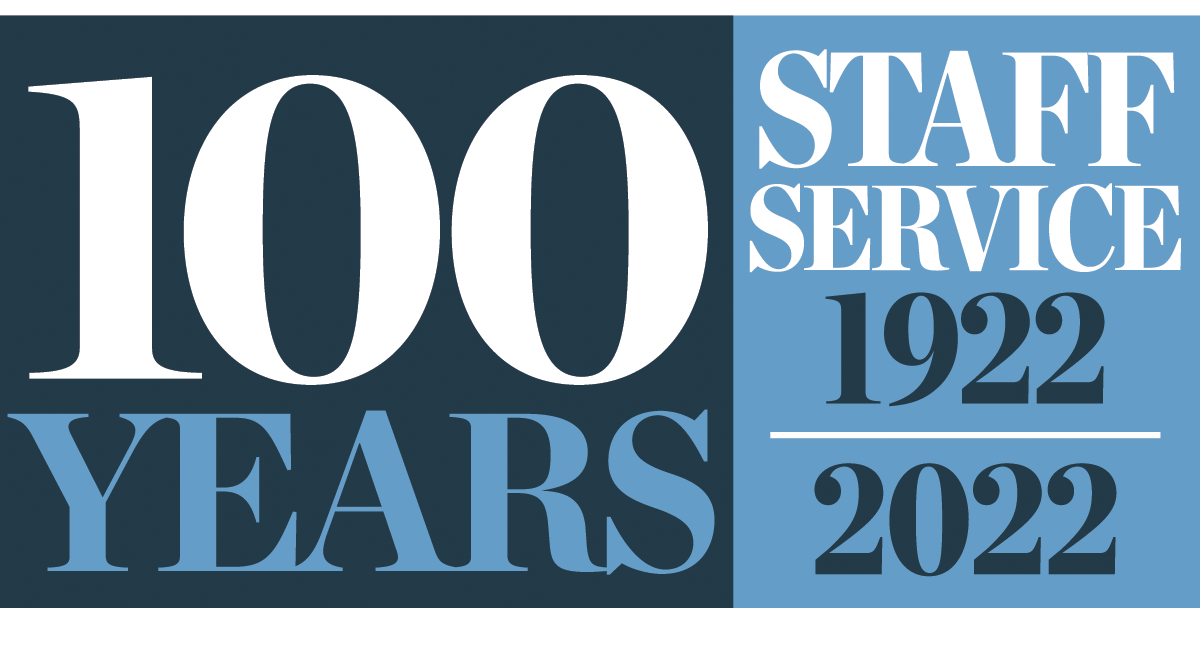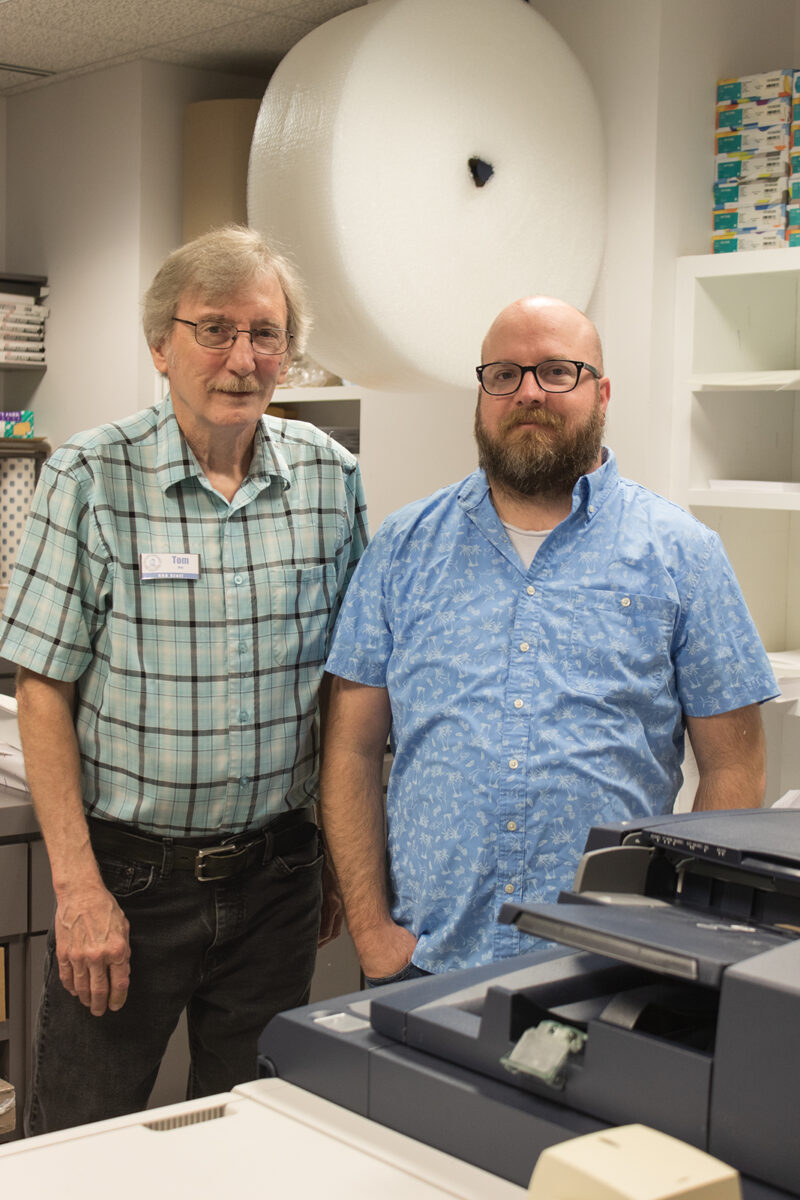How It's Made
Posted on July 15, 2022 This is part of a series on the 100th anniversary of the GAA hiring its first full-time, paid professional staff member for an organization that for 80 years prior had been run by volunteers.
This is part of a series on the 100th anniversary of the GAA hiring its first full-time, paid professional staff member for an organization that for 80 years prior had been run by volunteers.
Badges, nametags, posters, cards: all printed at the GAA.
Even as communication trends toward digital, some things still require ink applied to paper. Or plastic. Or magnets. For those occasions, the GAA uses its own print shop.
The print shop got its start in the early 1970s when then-Alumni Secretary Clarence Whitefield ’44 invested in a single-color printing press to replace a countertop copier that had broken down once too often. Previously, the GAA had only an office mimeograph machine.
The alumni offices filled the apartment house next to the Carolina Inn at the time. The alumni secretary’s office was off the mailroom. On Tom May’s first day on the job in 1986 as manager of the mailroom, he noticed the large, floor-model offset press set up in a ground-floor room in the back. The distinctive scent of ink and chemicals brought him back to his youth. His father was a printer in Ohio, where May grew up, and May worked in quality control at an ink factory in Cleveland while he was in college. There, he learned to operate a similar press to test the inks.
“I can run that,” May told Bo Dunlap ’64, who handled operations for the alumni association then. “My job immediately expanded from mailman to mailman and print shop guy,” May said.
Over the past three decades, May has grown the shop’s capabilities as the GAA’s needs have become more complex. “Taking it to where it is now,” he said of the print shop, “is like raising a child.”

Tom May (left) ran the GAA’s print shop from 1986 until a soft retirement that began in 2020. Daniel Alderman is now at the helm. Photo: Jason D. Smith ’94
Dunlap gave May plenty of leeway to apply his creativity to the job. “As long as I could get it done, he’d say, ‘Do it’ — as long as it didn’t cost too much money,” May said.
May added artwork to printed pieces by cutting and pasting, precision work that he enjoyed. Then he came up with a way to print two-color pieces on a single-color press. He’d do one press run with black ink and let the printed pieces dry for a few hours while he cleaned the black ink off the press. He’d make a separate electrostatic plate for the areas he wanted to have an additional color and fit the plate on the cylinder. Then, making sure the plate and page were precisely aligned, he ran the printed pages back through the press again. “It was rudimentary,” he said, “but it gave us another level of quality.”
The GAA also had a Pitney Bowes friction-feed folder that folded mailings to fit in an envelope or to be stapled or glued before May fed them through a postage meter and delivered them to the post office.
In time, the GAA bought an attachment that sprayed fine powder on the sheets as they came off the press, which allowed May to print on coated paper without the pages sticking together. And the shop acquired a guillotine cutter that, when the GAA moved the shop into the basement of the new George Watts Hill Alumni Center, took four men “bigger than football players” to move it, May said.
Once in the new center, the printing press was never hooked up. “The building was too clean,” May speculated. “With all the solvents and chemicals and inks, you can’t help but make a mess.”
But technology had evolved. The GAA leased a high-quality, two-color analog copier. Every few years when the copier’s lease came up for renewal, the GAA could upgrade its equipment to take advantage of new features. The print shop secured a better folding machine and a device that creases the document without tearing the paper fibers and disrupting the color and allows the address and barcode to show through a window envelope.
Over the years, the print shop has acquired a laminator (for standup posters), a machine that makes plastic cards (for student membership and life membership cards) and a high-quality copier to reproduce photographs.
May planned to retire in 2020 but agreed to stay on for a year, gradually cutting back his hours as he trained his successor. “I wanted the position to succeed and my replacement to succeed,” he said.
The pandemic disrupted that timeline. The GAA hired Daniel Alderman in November 2020, but there was no in-person Commencement and Reunions Weekend in 2021, the testing ground for a printer, which has to churn out thousands of pieces, including nametags, tickets, programs and stickers. “It all comes to you quickly, and from different sources, and has to be done right away,” May said.
May, and now Alderman, have printed much of what alumni have come to expect when receiving association mail or the accoutrements at reunions. It’s a craft few know.
Alderman’s experience sets a good foundation as he adapts to the types of printing and services the shop has provided over the years, May said. Alderman will continue with the stamp of quality that has encompassed the work of the print shop. “Quality of product and service are an important aspect,” May said. “Many times the pieces we produce are the first impression for future Carolina Alumni members.”
Since the alumni center building reopened after COVID lockdowns, May has been filling in at the reception desk, close by if Alderman or other staff have questions. And every once in a while, he said, “I go downstairs and print.”
— Nancy E. Oates
